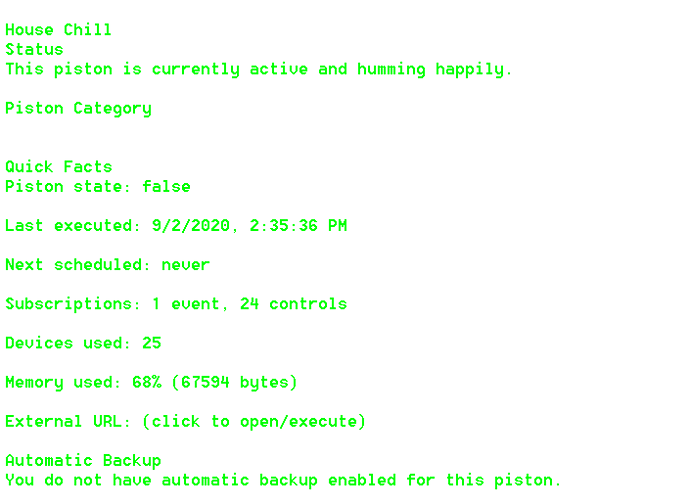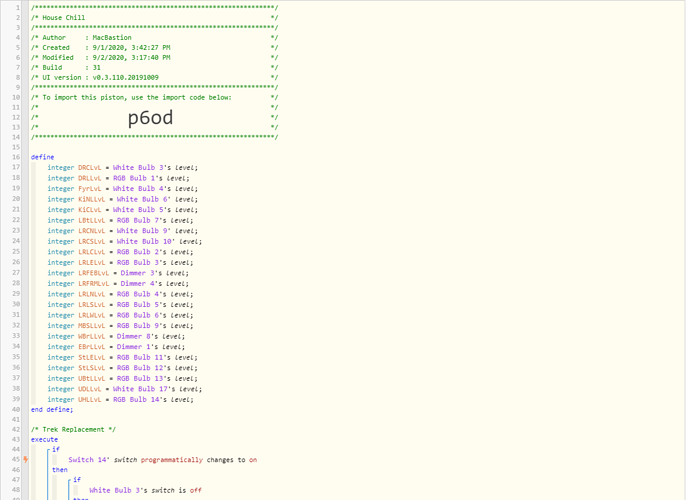1) Give a description of the problem
Hi, With Gentle wake up being broken now I am having to recreate the actions that were being performed by that app. In short the piston runs the devices sequentially (synchronous?) rather than simultaneously (Asynchronous?). I have read innumerable articles but can not quite grasp where to change to “Asynchronous” in the piston or if it will even work with fade vs wait (tried both).
2) What is the expected behaviour?
With the execution of a virtual switch 23 lights shall have their switch status and last known brightness level stored as a variable (works fine). The variable shall be applied dependent on switch status (Off= 0%, On={Current level}%)(works fine). Each individual bulb or switch (henceforth “device”) shall Dim / brighten accordinly from the current level to 20% over a period of 10 minutes (Error here), then proceed to turn off the virtual switch (works fine) and change the location mode (works fine).
3) What is happening/not happening?
When running the “do” loops for each device the piston… “waits” 10 minutes @ each light until the desired level % is attained. Running down the list of devices sequentially rather than all device simultaneously. this causes the piston to run 230 minutes rather than 10. What you cannot see in the log below is that after the piston runs one device it proceeds to the next. Dining Room Lamp to Dining Room Ceiling light. The start level% works, the end level% works it is just the sequential vs simultaneous that is eluding me.
4) Post a Green Snapshot of the piston![]()
5) Attach logs after turning logging level to Full
9/2/2020, 3:21:02 PM +819ms
+0ms ╔Received event [GLR House].test = 1599074462818 with a delay of 0ms
+183ms ║RunTime Analysis CS > 23ms > PS > 29ms > PE > 131ms > CE
+188ms ║Runtime (88994 bytes) successfully initialized in 29ms (v0.3.110.20191009) (187ms)
+189ms ║╔Execution stage started
+204ms ║║Condition #2 evaluated false (11ms)
+205ms ║║Condition group #1 evaluated false (state did not change) (12ms)
+216ms ║║Comparison (enum) on is (string) on = true (1ms)
+218ms ║║Cancelling condition #65’s schedules…
+219ms ║║Condition #65 evaluated true (11ms)
+220ms ║║Cancelling condition #64’s schedules…
+221ms ║║Condition group #64 evaluated true (state changed) (13ms)
+224ms ║║Cancelling statement #72’s schedules…
+251ms ║║Skipped execution of physical command [Dining Room Lamp].setLevel([80]) because it would make no change to the device. (11ms)
+252ms ║║Executed [Dining Room Lamp].setLevel (13ms)
+260ms ║║Skipped execution of physical command [Dining Room Lamp].on([]) because it would make no change to the device. (6ms)
+261ms ║║Executed [Dining Room Lamp].on (8ms)
+284ms ║║Skipped execution of physical command [Dining Room Lamp].setLevel([80]) because it would make no change to the device. (9ms)
+326ms ║║Executed virtual command [Dining Room Lamp].fadeLevel (53ms)
+327ms ║║Requesting a wake up for Wed, Sep 2 2020 @ 3:31:03 PM EDT (in 600.1s)
+359ms ║╚Execution stage complete. (169ms)
+380ms ║Setting up scheduled job for Wed, Sep 2 2020 @ 3:21:13 PM EDT (in 9.918s), with 61 more jobs pending
+388ms ╚Event processed successfully (388ms)
Clear
Full
REMOVE BELOW AFTER READING


